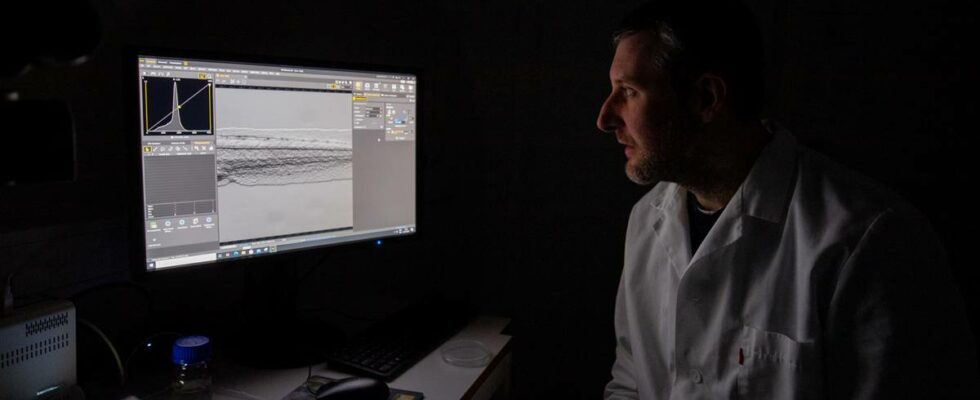– What we see here is the main vein of the zebrafish. In a cellar at Ullandhaug in Stavanger, researcher Federico Fenaroli points to the screen. There we see the fetus of a zebrafish that has recently been injected with some cancer cells. The advantage is, among other things, that the researchers can see right through the fish and monitor the cancer cells. Here is the tail. Photo: Screenshot The researcher follows along. Fenaroli hopes to kill these cells without damaging the healthy cells of the fish. Because if he can do that, there is a good chance of being able to do the same in people with cancer. We are talking about a new, targeted drug against cancer that will produce far fewer side effects. Fenaroli and the University of Stavanger (UiS) have received NOK 12 million from the Research Council to develop this. – Don’t just survive – You shouldn’t just survive life, you should live it. We meet Nina Egeland Amundsen at her home in Kvernaland on Jæren. She was diagnosed with breast cancer in 2015, and a few years later she was diagnosed with uterine cancer. The disease and the treatment were tough, but today she is completely cancer-free. The 43-year-old feels lucky to be alive. At the same time, today she has to cope with late-stage injuries from the treatment. Nina Egeland Amundsen Photo: Rolv Christian Topdahl / news And Egeland Amundsen is not alone. More and more of the 4,000 who get breast cancer each year survive, but many have problems with side effects. For example, several patients get chronic fatigue, or problems with the heart or lungs after finishing treatment. – There are more people struggling to get back into working life. I also hope that I will get there one day, she says. Now Egeland Amundsen puts his trust in the research of Federico Fenaroli. He uses cancer cells from an aggressive form of breast cancer in his work. Facts about breast cancer Breast cancer is the most common form of cancer in women. In 2022, 4,224 women will get breast cancer. Each year, the disease affects between 20 and 30 men. 9 out of 10 women who are affected by breast cancer survive for five years or more. In Norway today, there are close to 57,000 people who have recovered from or are living with breast cancer. Of these, around 6 percent live with a spread. Source: The Cancer Registry – As little soldiers, Emiel Janssen, head of the research group at the department of pathology at Stavanger University Hospital, is also involved in the project. He compares the method to a Trojan horse full of small soldiers. Emiel Janssen at the laboratory for molecular biology in Stavanger. Photo: Rolv Christian Topdahl / news – Today’s treatment is more like sending in rockets and drones, and then a lot of unnecessary damage occurs, says Janssen. More specifically, the method involves wrapping the medicine in nanoparticles, and then sending the particles into the cancer cells. But the whole point is that the particles with the medicine should only enter the cancer cells and not the healthy cells. Federico Fenaroli shows a new image on the screen, of red and green cells. He has simulated how the method will work in practice, and is satisfied: The red cells are healthy and have not received any nanoparticles, but the green cancer cells have. Researcher Federico Fenaroli shows off the cells. Photo: Rolv Christian Topdahl / news – By doing this, we can potentially kill the cells, says Fenaroli, who is a researcher at the Department of Chemistry, Life Sciences and Environmental Technology at UiS. Did you get the story of Sigrunn Landa, who put cancer treatment on hold to be able to become a mother? – A revolution And the method should be able to be used on forms of cancer other than breast cancer – if the research is successful. – This could be a revolution in cancer treatment. Because then we can attack many more types of cancer than just these variants of breast cancer cells, such as prostate cancer and colon cancer, says Janssen. Apart from Fenaroli, two researchers and an assistant will work on the project full-time for three years. But it will be some time before the method can be used on cancer patients. Because after the method has been tested on fish, mice and rats must be avoided, and then monkeys, before the method can be tested on humans. This process can easily take ten years. – Very promising CEO of the Breast Cancer Association, Camilla Skare, is “incredibly happy” to hear about the research project and the award from the Research Council. Camilla Skare, general manager of the Breast Cancer Association. Photo: Erik Thallaug/Breast Cancer Association – Nanotechnology has shown very promising results both in the field of diagnostics and treatment of cancer and will be able to contribute to increased survival and more targeted treatment, which also has a lot to say for the quality of life and late damage for the patient, she says. Regional manager Geir Vangsnes of the Vestland Cancer Association points out that cancer research and survival are closely intertwined. Geir Vangsnes, regional manager of the Cancer Society. Photo: Leif Rune Løland / news – Research is the hope, and what makes the survival rate in breast cancer increase as strongly as it has. New treatment methods, better medicines, better diagnostics – everything plays a role, he says. Need some encouragement? Read about five good news about cancer treatment. Published 03.11.2024, at 07.54
ttn-69
Researchers have received millions to use fish in “revolutionary” cancer research – news Rogaland – Local news, TV and radio

